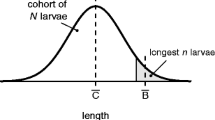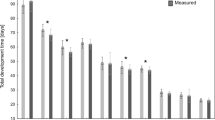Abstract
Many authors produced carrion insect development data for predicting the age of an insect from a corpse. Under some circumstances, this age value is a minimum postmortem interval. There are no standard protocols for such experiments, and the literature includes a variety of sampling methods. To our knowledge, there has been no investigation of how the choice of sampling method can be expected to influence the performance of the resulting predictive model. We calculated 95 % inverse prediction confidence limits for growth curves of the forensically important carrion flies Chrysomya megacephala and Sarconesia chlorogaster (Calliphoridae) at a constant temperature. Confidence limits constructed on data for entire age cohorts were considered to be the most realistic and were used to judge the effect of various subsampling schemes from the literature. Random subsamples yielded predictive models very similar to those of the complete data. Because taking genuinely random subsamples would require a great deal of effort, we imagine that it would be worthwhile only if the larval measurement technique were especially slow and/or expensive. However, although some authors claimed to use random samples, their published methods suggest otherwise. Subsampling the largest larvae produced a predictive model that performed poorly, with confidence intervals about an estimate of age being unjustifiably narrow and unlikely to contain the true age. We believe these results indicate that most forensic insect development studies should involve the measurement of entire age cohorts rather than subsamples of one or more cohorts.



Similar content being viewed by others
References
Wells JD, LaMotte LR (2010) Estimating the postmortem interval. In: Byrd JH, Castner JL (eds) Forensic entomology: the utility of arthropods in legal investigations. CRC, Boca Raton, pp 367–388
Greenberg B (1991) Flies as forensic indicators. J Med Entomol 28:565–577
Byrd JH, Butler JF (1998) Effect of temperature on Sarcophaga haemorrhoidalis (Diptera: Sarcophagidae) development. J Med Entomol 35:694–698
Grassberger M, Reiter C (2001) Effect of temperature on Lucilia sericata (Diptera: Calliphoridae) development with special reference to the isomegalen- and isomorphen-diagram. Forensic Sci Int 120:32–36
Dadour IA, Cook DF, Wirth N (2001) Rate of development of Hydrotea rostrata under summer and winter (cyclic and constant) temperature regimes. Med Vet Entomol 15:177–182
Donovan SE, Hall MJR, Turner BD, Moncrieff CB (2006) Larval growth rates of the blowfly, Calliphora vicina, over a range of temperatures. Med Vet Entomol 20:106–114
National Research Council (2009) Strengthening forensic science in the United States: a path forward. National Academies, Washington
Wells JD, LaMotte LR (1995) Estimating maggot age from weight using inverse prediction. J Forensic Sci 40:585–590
Kamal AS (1958) Comparative study of thirteen species of sarcosaprophagous Calliphoridae and Sarcophagidae (Diptera) I. Bionomics. Ann Entomol Soc Am 51:261–271
Greenberg B, Wells JD (1998) Forensic use of Megaselia abdita and M. scalaris (Phoridae: Diptera): case studies, development rates, and egg structure. J Med Entomol 35:205–209
Byrd JH, Allen JC (2001) The development of the black blow fly, Phormia regina (Meigen). Forensic Sci Int 120:79–88
Carvalho LML, Linares AX, Trigo JR (2001) Determination of drug levels and the effect of diazepam on the growth of necrophagous flies of forensic importance in southeastern Brazil. Forensic Sci Int 120:140–144
Tarone AM, Foran DR (2006) Components of developmental plasticity in a Michigan population of Lucilia sericata (Diptera: Calliphoridae). J Med Entomol 42:1023–1033
Richards CS, Paterson ID, Villet MH (2008) Estimating the age of immature Chrysomya albiceps (Diptera: Calliphoridae), correcting for temperature and geographical latitude. Int J Legal Med 122:271–279
Vélez MC, Wolff M (2008) Rearing of five species of Diptera (Calliphoridae) of forensic importance in Colombia in semicontrolled field conditions. Pap Avulsos Zool 48:41–47
Boatright SA, Tomberlin JK (2010) Effects of temperature and tissue type on the development of Cochliomyia macellaria (Diptera: Calliphoridae). J Med Entomol 47:917–923
Byrd JH, Butler JF (1997) Effect of temperature on Chrysomya rufifacies (Diptera: Calliphoridae) development. J Med Entomol 34:355–358
Grassberger M, Reiter C (2002) Effect of temperature on development of the forensically important Holarctic blow fly Protophormia terraenovae (Robineau-Desvoidy) (Diptera: Calliphoridae). Forensic Sci Int 128:177–182
Grassberger M, Friedrich E, Reiter C (2003) The blowfly Chrysomya albiceps (Wiedemann) (Diptera: Calliphoridae) as a new forensic indicator in Central Europe. Int J Legal Med 117:75–81
Sukontason K, Piangjai S, Siriwattanarungsee S, Sukontason KL (2008) Morphology and development rate of blowflies Chrysomya megacephala and Chrysomya rufifacies in Thailand: application in forensic entomology. Parasit Res 102:1207–1216
Davies L, Ratcliffe GG (1994) Development rates of some pre-adult stages in blowflies with reference to low temperatures. Med Vet Entomol 8:245–254
El-Kady EM, Kheirallah AM, Kayed AN, Dekinesh SI, Ahmed ZA (1999) The development and growth of the house fly Musca domestica vicina and the blowfly Lucilia sericata. Pak J Biol Sci 2:498–502
Kumara TK, Abu Hussan A, Che Salmah MR, Bhupinder S (2009) Larval growth of the muscid fly, Synthesiomyia nudiseta (Wulp), a fly of forensic importance, in the indoor fluctuating temperatures of Malaysia. Trop Biomed 26:200–205
Goff ML, Brown WA, Omori AI (1992) Preliminary observations of the effect of metamphetamine in decomposing tissues on the development rate of Parasarcophaga ruficornis (Diptera: Sarcophagidae) and implications of this effect on the estimation of postmortem intervals. J Forensic Sci 37:867–872
Greenberg B, Tantawi TI (1993) Developmental strategies in two boreal blow flies (Diptera: Calliphoridae). J Med Entomol 30:481–484
Steel RGD, Torrie JH (1980) Principles and procedures of statistics. A biometrical approach, 2nd edn. McGraw-Hill, New York
Wells JD, Kurahashi H (1994) Chrysomya megacephala (Fabricius) development: rate, variation and the implications for forensic entomology. Jpn J Sanit Zool 45:303–309. (http://jsmez.gr.jp/wordpress/journal/archives/volume-index/article?articleID=110003818474)
Baqué M, Amendt J (2013) Strengthening forensic entomology in court—the need for data exploration and the validation of a generalised additive mixed model. Int J Legal Med 127:213–223
SAS Institute Inc (2013) SAS user’s guide. SAS Institute Inc, Cary
Tarone AM, Foran DR (2013) Gene expression during blow fly development: improving the precision of age estimates in forensic entomology. J Forensic Sci 56:S112–S122
Boehme P, Spahn P, Amendt J, Zehner R (2013) Differential gene expression during metamorphosis: a promising approach for age estimation of forensically important Calliphora vicina pupae (Diptera: Calliphoridae). Int J Legal Med 127:243–249
Haskell NH, Williams RE (1990) Collection of evidence at the death scene. In: Catts EP, Haskell NH (eds) Entomology & death. A procedural guide. Joyce’s Print Shop, Clemson, pp 82–97
Acknowledgments
We thank Liliana Likourentzos (Florida International University) for help with data management. This work was supported in part by National Institute of Justice award 2013-DN-BX-K042 to L.R.L. and J.D.W. and by grants from the Conselho de Desenvolvimento Científico e Tecnológico–CNPq to M.C.L and M.O.M. The opinions expressed here do not necessarily reflect those of the U.S. Department of Justice.
Author information
Authors and Affiliations
Corresponding author
Electronic supplementary material
Below is the link to the electronic supplementary material.
ESM 1
(XLSX 41 kb)
Rights and permissions
About this article
Cite this article
Wells, J.D., Lecheta, M.C., Moura, M.O. et al. An evaluation of sampling methods used to produce insect growth models for postmortem interval estimation. Int J Legal Med 129, 405–410 (2015). https://doi.org/10.1007/s00414-014-1029-6
Received:
Accepted:
Published:
Issue Date:
DOI: https://doi.org/10.1007/s00414-014-1029-6




